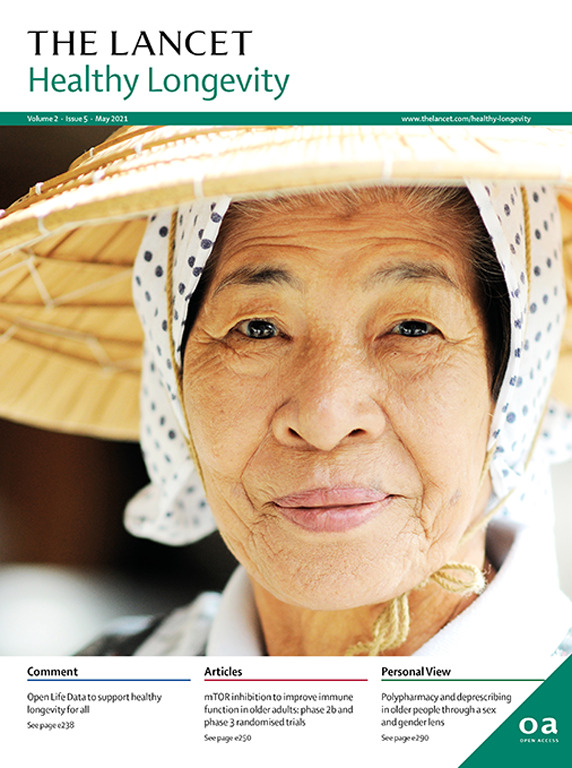Pneumococcal vaccination for new residents entering older adult care homes in England: national observational surveillance study
IF 14.6
Q1 GERIATRICS & GERONTOLOGY
引用次数: 0
Abstract
Background
The incidence of invasive pneumococcal disease (IPD) increases rapidly with age. In the UK, adults aged 65 years are eligible for the 23-valent pneumococcal polysaccharide vaccine (PPV23) as part of the national immunisation programme, and a 20-valent pneumococcal conjugate vaccine (PCV20) was recently licensed for adults. Residents of care homes for older adults have a higher risk of IPD and death than the general population. We estimated the potential effect of an additional dose of PPV23 or PCV20 for new residents entering older adult care homes.
Methods
In this observational surveillance study, we used national IPD surveillance and care home resident data from England. Care homes for older adults were defined as residential care and nursing homes registered with the Care Quality Commission for adults aged 65 years and older. IPD in adults aged 65 years and older in England was assessed in the 2022–23 epidemiological year (July 1, 2022, to June 30, 2023) by sex and 5-year age bands using data obtained from UK Health Security Agency national IPD surveillance. We calculated the number needed to vaccinate (NNV) with PPV23 or PCV20 in the population of new care home residents to prevent one vaccine-type IPD case and one death compared with adults aged 65 years who were vaccinated as part of the national immunisation programme in England.
Findings
In 2022–23, there were 2574 IPD cases among 10 629 867 people aged 65 years and older in England. Of these, 603 109 were aged 65 years. Of the 2574 cases, 69·4% (1787 of 2574) were due to PPV23 serotypes and 60·8% (1566 of 2574) were due to PCV20 serotypes. Under the assumption of 36% vaccine effectiveness against PPV23-type IPD and 18% vaccine effectiveness against death, PPV23, when offered to all 603 109 adults aged 65 years in the general population, could prevent 163 (36%) of 452 cases (NNV 3700) and 31 (47%) of 66 PPV23-type IPD associated deaths over 5 years (NNV 19 455). However, vaccinating 121 587 new care home residents with PPV23 could prevent 177 (36%) of 492 lifetime cases (NNV 687) and 111 (48%) of 233 deaths (NNV 1095). In all adults aged 65 years in the general population, PCV20 could prevent 303 (75%) of 404 cases (NNV 1990) and 43 (80%) of 54 PCV20-type IPD deaths (NNV 14 026), assuming 75% vaccine effectiveness against PCV20-type IPD and 18% against death. However, vaccinating 121 587 new care home residents with PCV20 could prevent 317 (75%) of 422 cases (NNV 384) and 157 (80%) of 197 deaths (NNV 774).
Interpretation
Pneumococcal vaccination for new care home residents could prevent substantially more cases and deaths per dose and would require only 20% more doses than the current national PPV23 programme for adults aged 65 years. PCV20 is likely to have a greater impact against IPD and death than PPV23.
Funding
None.
肺炎球菌疫苗接种新居民进入老年成人护理之家在英格兰:国家观察性监测研究。
背景:侵袭性肺炎球菌病(IPD)的发病率随着年龄的增长而迅速增加。在英国,65岁的成年人有资格接种23价肺炎球菌多糖疫苗(PPV23),作为国家免疫计划的一部分,20价肺炎球菌结合疫苗(PCV20)最近获准用于成人。老年人护理院的居民患IPD和死亡的风险高于一般人群。我们估计了额外剂量的PPV23或PCV20对进入老年人护理之家的新居民的潜在影响。方法:在这项观察性监测研究中,我们使用了英国全国IPD监测和护理院居民的数据。老年人护理院被定义为在护理质量委员会为65岁及以上的成年人注册的住宿护理和养老院。在2022-23流行病学年(2022年7月1日至2023年6月30日),使用英国卫生安全局国家IPD监测数据,按性别和5岁年龄组对英格兰65岁及以上成年人的IPD进行了评估。我们计算了新护理院居民接种PPV23或PCV20疫苗(NNV)所需的数量,以预防1例疫苗型IPD病例和1例死亡,与在英格兰接种疫苗作为国家免疫计划一部分的65岁成年人相比。研究结果:2022-23年,英格兰65岁及以上的10629867人中有2574例IPD病例。其中603109人年龄在65岁。2574例中,PPV23型占69.4%(1787例),PCV20型占68%(1566例)。假设疫苗对PPV23型IPD的有效性为36%,对死亡的有效性为18%,当向所有603109名65岁的普通人群提供PPV23疫苗时,5年内可预防452例(NNV 3700)中的163例(36%)和66例PPV23型IPD相关死亡(NNV 19455)中的31例(47%)。然而,为121287名新养老院居民接种PPV23可以预防492例(NNV 687)中的177例(36%)和233例死亡(NNV 1095)中的111例(48%)。在一般人群中所有65岁的成年人中,PCV20可以预防404例(NNV 1990)中的303例(75%)和54例PCV20型IPD死亡(NNV 14026)中的43例(80%),假设疫苗对PCV20型IPD的有效性为75%,对死亡的有效性为18%。然而,为121587名新养老院居民接种PCV20疫苗可以预防422例(NNV 384)中的317例(75%)和197例(NNV 774)死亡中的157例(80%)。解释:为新养老院居民接种肺炎球菌疫苗可以预防更多的病例和死亡,并且只需要比目前国家65岁成人PPV23计划多20%的剂量。PCV20对IPD和死亡的影响可能比PPV23更大。资金:没有。
本文章由计算机程序翻译,如有差异,请以英文原文为准。
求助全文
约1分钟内获得全文
求助全文
来源期刊

Lancet Healthy Longevity
GERIATRICS & GERONTOLOGY-
CiteScore
16.30
自引率
2.30%
发文量
192
审稿时长
12 weeks
期刊介绍:
The Lancet Healthy Longevity, a gold open-access journal, focuses on clinically-relevant longevity and healthy aging research. It covers early-stage clinical research on aging mechanisms, epidemiological studies, and societal research on changing populations. The journal includes clinical trials across disciplines, particularly in gerontology and age-specific clinical guidelines. In line with the Lancet family tradition, it advocates for the rights of all to healthy lives, emphasizing original research likely to impact clinical practice or thinking. Clinical and policy reviews also contribute to shaping the discourse in this rapidly growing discipline.
 求助内容:
求助内容: 应助结果提醒方式:
应助结果提醒方式:


